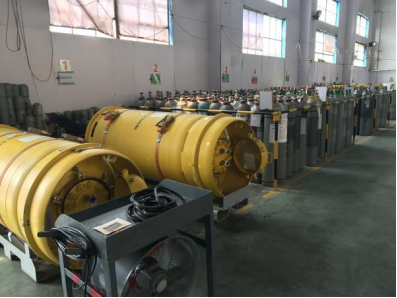Hydrogen chloride, with the chemical formula HCl, is a colorless gas with a pungent odor. A hydrogen chloride molecule is composed of one chlorine atom and one hydrogen atom. Its aqueous solution is called hydrochloric acid, also known as hydrochloric acid. Hydrogen chloride is very soluble in water. At 0°C, 1 volume of water can dissolve approximately 500 volumes of hydrogen chloride. Melting point -114.2℃, boiling point -85℃, does not burn in air, is thermally stable, and does not decompose until about 1500℃. It has a suffocating odor, is highly irritating to the upper respiratory tract, and is corrosive to eyes, skin, and mucous membranes. The density is greater than that of air, its aqueous solution is hydrochloric acid, and concentrated hydrochloric acid is volatile.
 Image source: Baidu
Image source: BaiduAccording to incomplete statistics, there are currently more than one hundred processes that use hydrogen chloride as a raw material, and less than fifty processes produce hydrogen chloride as a by-product; it is a very important part of the chlorine industry. With the rapid development of the chlorine industry in my country, especially With the expansion of the scale of organochlorine products, the total amount of by-product hydrogen chloride has increased year after year, and by-product hydrochloric acid and by-product high-purity hydrogen chloride gas have been derived. At present, the supply of hydrochloric acid exceeds demand in the market, and individual enterprises need to invest more costs to deal with excess hydrochloric acid. The hydrogen chloride market is relatively relatively Stablize.
Hydrogen chloride gas has a wide range of uses, such as the manufacture of dyes, spices, pesticides, pharmaceutical intermediates; synthetic catalysts, metal smelting ; important raw materials for etching, passivation, epitaxy and other processes in integrated circuits.
In addition to its various uses, hydrogen chloride is also harmful to the human body. Hydrogen chloride mainly damages the human body with its irritability and corrosiveness. Hydrogen chloride is highly irritating to the upper respiratory tract and corrosive to eyes, skin and mucous membranes. Inhalation of hydrogen chloride can cause rhinitis, laryngitis, bronchitis, pneumonia, headache, palpitation, and suffocation. When swallowed, it will stimulate the mouth, throat, esophagus and stomach, causing salivation, nausea, vomiting, intestinal perforation, chills and fever, anxiety, shock, nephritis. After inhalation, most of the hydrogen chloride is retained by the upper respiratory tract mucosa and partially neutralized, which can stimulate and burn the local mucosa, causing inflammatory edema, congestion and necrosis. Long-term operation in an environment with a concentration exceeding 15mg/m³ will cause chronic diseases such as tooth erosion and chronic bronchitis. Symptoms caused by the local action of hydrogen chloride are conjunctivitis, corneal necrosis, damage to the skin and mucous membranes, resulting in burns with severe pain. Long-term exposure to low-concentration hydrogen chloride can make the skin dry and earthy, and can also cause cough, headache, insomnia, dyspnea, hyperactivity of heart palpitations, severe stomach pain, etc. The obvious symptom of chronic poisoning is that the tooth surface becomes rough, especially the front teeth produce spots.
| Hydrogen chloride gas concentration | symptom |
| 9ppm | Begins to falter, but tolerable for six hours |
| 10ppm | Beginnings are influential |
| 35ppm | Tolerable for 10 minutes, but sneezing affects the throat, hoarseness, suffocation and chest pressure |
| 10-50ppm | Can work, can’t work if inhaled for a long time |
| 40-90ppm | It can be tolerated for 0.5 to 1 hour, and there will be no hindrance in the future |
| 1000-1350ppm | There is a risk within 0.5 to 1 hour |
| 1250-1750ppm, | Died within 0.5 to 1 hour or after 1 hour |
For the detection of hydrogen chloride gas concentration in the chlorine industry, ISWEEK recommends the following electrochemical gas sensors for the detection of gas in the chlorine industry.
British Alphasense hydrogen chloride sensor – HCL-A1
hydrogen chloride sensor – HCL-A1 electrochemical sensor has high sensitivity, good selectivity, can filter dust and small water droplets, low concentration output linearity, good stability, anti-SO2, H2, CO, C2H4 , CO2, NH3 interference and other advantages, the measuring range is 0~100ppm, the working environment is -30~50℃, 15~90%RH, and the resolution is 1ppm. It is mainly used in hand-held HCL alarms, chemical industry and other industrial fields.
British Alphasense hydrogen chloride sensor – HCL-B1
hydrogen chloride sensor – HCL-B1 electrochemical sensor has high sensitivity, good selectivity, can filter dust and small water droplets, low concentration output linearity, good stability, anti-SO2, H2, CO, C2H4 , CO2, NH3 interference and other advantages, the range is 0~100ppm, the working environment is -30~50℃, 15~90%RH, the resolution is 0.1ppm, mainly used in fixed HCL alarms, chemical industry and other industrial fields.






